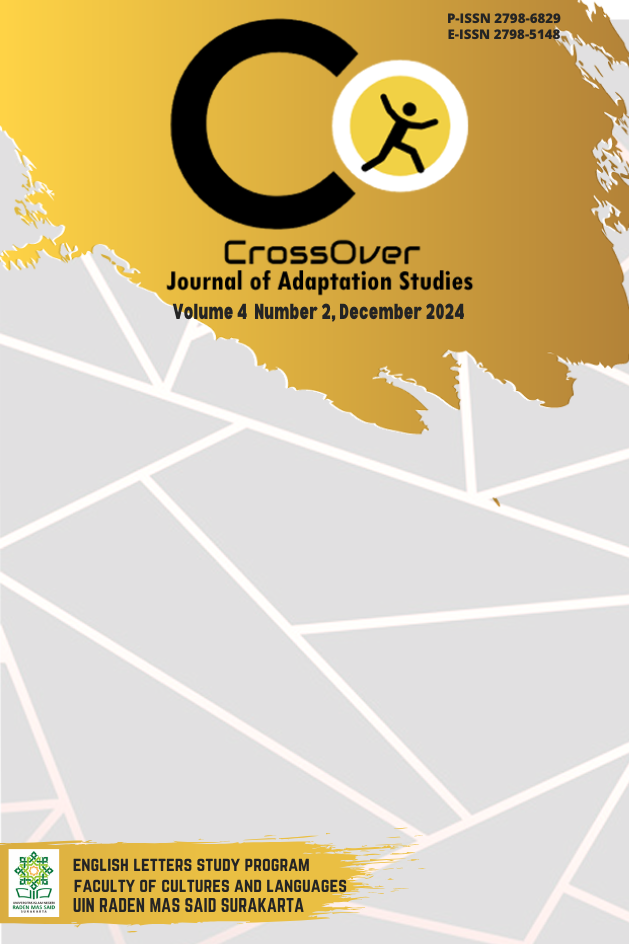FROM HAE CHAN TO HAIKAL: LOCALIZATION OF K-POP IDOL NAMES IN TWITTERATURE
DOI:
https://doi.org/10.22515/crossover.v4i2.10278Keywords:
localization, K-pop, idol's name, obligatory, aleatoryAbstract
Alternate Universe (AU) on Twitter employs public figures such as K-pop idols as characters and localized their names. K-pop idols already possess global appeal, but localization helps integrate these figures into regional or cultural contexts, making stories resonate deeply with local audiences. Name localization in this context is about adapting names to fit different languages and cultures. This research aims to investigate the localization of a K-pop idol’s names in the context AU based Twiterrature in X platform, formerly Twitter. The focus is to see how localization of K-pop idol names is applied in Twitterature, addresses a significant gap in existing studies by exploring the intersection of localization strategies. To analyze it we used localization based on Lyons (1977), the idea that spatial expressions are more essential, grammatically and semantically than non-spatial expressions. In this context, spatial expressions are the different strategies used to localize each K-pop generation. In order to localize, name translation could be expressed through aleatory and intentional techniques. To analyze the data we used Spradley 4 step technique; domain analysis, taxonomy analysis, componential analysis, and cultural theme analysis. The primary findings in this research indicate that the author's choice of names was frequently influenced by random or arbitrary factors rather than a systematic or thematic rationale. This study aims to enhance understanding of how localization strategies function in Twitterature, specifically in adapting global cultural figures like K-pop idols into localized and culturally relevant stories.
Downloads
References
Agustine, A., Jeanza, A. D., Pambudi, D. T., & Pandin, M. G. R. (2022). Analysis on Alternate Universe Popularity Effect on Digital-Era Society’s Reading Habit in Philosophical Perspective. https://doi.org/10.31219/osf.io/k5t96
Allim, R. P. N. (2023). Quick Chat Localization Quality Assesment Aas Seen From Mobile Legends:Bang-Bang, Arena of Valor, and Heroes Evolved. [Undergraduate thesis, UIN Raden Mas Said Surakarta]
Annisa, A. N. (2019). Localization Quality Assessment for Video Game Subtitle Entitled “Sastratsuki.” [Undergraduate Thesis, UIN Raden Mas Said Surakarta]
Bantas, A. (1994). Names, nicknames, and titles in translation. Perspective: Studies in Transtatology, 2(1), 79–87. http://dx.doi.org/10.1080/0907676X.1994.9961225
Behind The Name. (2015). Siwon. In Behind The Name.com dictionary. Retrieved November 15, 2024 from https://www.behindthename.com/name/si01won/submitted
Caesar, R. O. (2019). A Morphosyntactic Analysis of Dangme Allusive Names. Journal of Universal Language, 20(2), 53–93. https://doi.org/10.22425/jul.2019.20.2.53
Campbell, M. (2017). Horace. In Behind The Name.com dictionary. Retrieved November 17, 2024, from https://www.behindthename.com/name/horace
Campbell, M. (2017). Jaya. In Behind The Name.com dictionary. Retrieved November 15, 2024, from https://www.behindthename.com/element/jaya
Campbell, M. (2019). Chen. In Behind The Name.com dictionary. Retrieved November 21, 2024, from https://www.behindthename.com/name/chen-1
Campbell, M. (2024). Arjuna. In Behind The Name.com dictionary. Retrieved November 15, 2024, from https://www.behindthename.com/name/arjuna
Campbell, M. (2024). Cahyo. In Behind The Name.com dictionary. Retrieved November 15, 2024, from https://www.behindthename.com/name/cahyo
Campbell, M. (2024). Mark. In Behind The Name.com dictionary. Retrieved November 15, 2024, from https://www.behindthename.com/name/mark
Campbell, M. (2024). Yudha. In Behind The Name.com dictionary. Retrieved November 15, 2024, from https://www.behindthename.com/name/yuda
De La Cova, E. (2021). Language and Brand: Problems for Localization. HERMES - Journal of Language and Communication in Business, 61, 63–75. https://doi.org/10.7146/hjlcb.vi61.127925
Elbowin and Sekejap (2024). Maulana. In Behind The Name.com dictionary. Retrieved November 15, 2024, from https://www.behindthename.com/name/maulana/submitted
Esselink, B. (2003). The evolution of localization. The Guide from Multilingual Computing & Technology: Localization, 14(5), 4–7. https://www.intercultural.urv.cat/media/upload/domain_317/arxius/Technology/Esselink_Evolution.pdf
Fernandes, L. (2006). Translation of Names in Children’s Fantasy Literature: Bringing the Young Reader into Playi. New Voice in Translation Studies, 2(1), https://doi.org/10.14456/nvts.2006.5
Fifles, J. J. (2018). Airlangga. In Behind The Name.com dictionary. Retrieved November from
https://www.behindthename.com/name/airlangga/submitted
HL (2020). Nakamoto. In Behind The Name.com dictionary. Retrieved November 15, 2024, from https://surnames.behindthename.com/name/nakamoto/submitted
HL and sekejap (2024). Aji. In Behind The Name.com dictionary. Retrieved November 15, 2024, from https://www.behindthename.com/name/aji/submitted
Kim, R. B., & Sieun, L. (2019). The Effect of Localization and Production Image on Chinese & Korean Consumers’ Choice for Animation Movies. Asia-Pacific Social Science Review, 19(2). https://doi.org/10.59588/2350-8329.1222
Lyons, J. (1977). Semantics. Cambridge University Press.
Mohamed Mohamed Yousef, A. (2024). Translating English Fiction Titles and Cinema-TV Works Headlines into Arabic: Towards Localization Orientation. مجلة کلية الآداب, 70(70), 0–0. https://doi.org/10.21608/bfa.2023.230664.1229
Molina, L., & Hurtado Albir, A. (2004). Translation Techniques Revisited: A Dynamic and Functionalist Approach. Meta, 47(4), 498–512. https://doi.org/10.7202/008033ar
Parianou, A. (2007). Translating Proper Names: A Functionalist Approach. Names, 55(4), 407–416. https://doi.org/10.1179/nam.2007.55.4.407
Sauro, S. (2019). Fan Fiction and Informal Language Learning. Dalam M. Dressman & R. W. Sadler (Ed.), The Handbook of Informal Language Learning (1 ed., hlm. 139–151). Wiley. https://doi.org/10.1002/9781119472384.ch9
sekejap (2024). Haykal. In Behind The Name.com dictionary. Retrieved November 15, 2024, from https://www.behindthename.com/name/haykal/submitted
Sofia (2016). Xiaojun. In Behind The Name.com dictionary. Retrieved November 15, 2024, from https://www.behindthename.com/name/xiaojun/submitted
Spradley, J. P. (1980). Participant observation. Harcourt Brace Jovanovich College.
Tichelaar, T. (2023). Geographical Names as Cultural Heritage.
Verma, S. (2024). Decoding the 4 Generations of K-pop. In Halsugprod.com. Retrieved November 22, 2024, from https://halsugprod.com/blog/decoding-four-generations-of-kpop
Vermes, A. P. (2003). Proper Names in Translation: An Explanatory Attempt. Across Languages and Cultures, 4(1), https://doi.org/10.1556/Acr.4.2003.1.5
Zarei, R., & Norouzi, S. (2014). Proper Nouns in Translation: Should They Be Translated? International Journal of Applied Linguistics & English Literature, 3(6). https://doi.org/10.7575/aiac.ijalel.v.3n.6p.152
Downloads
Published
How to Cite
Issue
Section
Citation Check
License
Copyright (c) 2025 Naura Mukti Larasati, Amala Nadhifa, Amanda Putri Vebya, Choi

This work is licensed under a Creative Commons Attribution-ShareAlike 4.0 International License.
Authors retain copyright and grant the journal right of first publication with the work simultaneously licensed under a Creative Commons Attribution 4.0 International License that allows others to share the work with an acknowledgment of the work's authorship and initial publication in this journal.

















